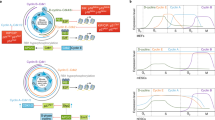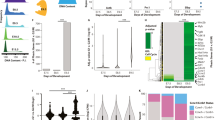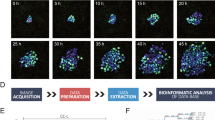Abstract
One of the characteristic features of human embryonic stem cells (hESCs) is the competence for self-renewal and pluripotency. To date, little is known about cell cycle regulation in these cells and how the cell cycle machinery influences hESCs properties. A common feature of human, murine and primate ESCs is the presence of a short G1 phase, which has been viewed as a time window during which stem cells are exposed to differentiation signals. We used the hESCs differentiation model and comparisons to human embryonic carcinoma (EC) cells to study the key regulators of G1 to S transition in hESCs. Our studies show that hESCs express all G1-specific CYCLINs (D1, D2, D3 and E) and cyclin-dependent kinases (CDK) (CDK2, CDK4 and CDK6) at variable levels. In contrast to murine ESCs, most of the cell cycle regulators in hESCs show cell cycle-dependent expression, thus revealing important differences in the expression of cell cycle regulatory components between these two embryonic cell types. Knockdown of CDK2 using RNA interference resulted in hESCs arrest at G1 phase of the cell cycle and differentiation to extraembryonic lineages. This suggests an important role for CDK2 in cell cycle regulation in hESCs that are likely to bear significant impacts on the maintenance of their pluripotent phenotype.
This is a preview of subscription content, access via your institution
Access options
Subscribe to this journal
Receive 50 print issues and online access
$259.00 per year
only $5.18 per issue
Buy this article
- Purchase on Springer Link
- Instant access to full article PDF
Prices may be subject to local taxes which are calculated during checkout





Similar content being viewed by others
References
Andrews PW, Martin MM, Bahrami AR, Damjanov I, Gokhale P, Draper JS . (2005). Embryonic stem (ES) cells and embryonic carcinoma (EC) cells: opposite sides of the same coin. Biochem Soc Trans 33: 1526–1530.
Armstrong L, Hughes O, Yung S, Hyslop L, Stewart R, Wappler I et al. (2006). The role of PI3K/AKT, MAPK/ERK and NFkB signaling in the maintenance of human embryonic stem cell pluripotency and viability highlighted by transcriptional profiling and functional analysis. Human Mol Genetics 15: 1894–1913.
Becker KA, Ghue PN, Therrien JA, Lian JB, Stein JL, van Wijnen AJ et al. (2006). Self-renewal of human embryonic stem cells is supported by a shortened G1 cell cycle phase. J Cell Physiol 209: 883–893.
Becker KA, Stein JL, Lian JB, van Wijnen AJ, Stein GS . (2007). Establishment of histone gene regulation and cell cycle checkpoint control in human embryonic stem cells. J Cell Physiol 210: 517–526.
Blomen V, Boonstra J . (2007). Cell fate determination during G1 phase progression. Cell Mol Life Sci 24: 1789–1793.
Brons G, Smithers LE, Trotter MWB, Rugg-Gunn P, Sun B, Chuva SM et al. (2007). Derivation of pluripotent epiblast stem cells from mammalian embryos. Nature 448: 191–195.
Boyer LA, Lee TL, Cole MF, Johnstone SE, Levine SS, Zucker JP et al. (2005). Core transcriptional regulatory circuitry in human embryonic stem cells. Cell 122: 947–956.
Calegari F, Haubensak W, Haffner C, Huttner WB . (2005). Selective lengthening of the cell cycle in the neurogenic subpopulation of neural progenitor cells during mouse brain development. J Neurosci 25: 6533–6538.
Calegari F, Huttner WB . (2003). An inhibition of cyclin-dependent kinases that lengthens, but does not arrest, neuroepithelial cell cycle induces premature neurogenesis. J Cell Sci 116: 4947–4955.
Carpenter MK, Rosler E, Rao MS . (2003). Characterisation and differentiation of human embryonic stem cells. Cloning Stem Cells 5: 79–88.
Enver T, Soneji S, Joshi C, Brown J, Iborra F, Orntoft T et al. (2005). Cellular differentiation hierarchies in normal and culture-adapted humab embryonic stem cells. Hum Mol Genet 14: 3129–3140.
Faast R, White J, Cartwright P, Crocker L, Sarcevic B, Dalton S . (2004). Cdk6-cyclin D3 activity in murine ES cells is resistant to inhibition by p16 (INK4a). Oncogene 23: 491–502.
Fluckiger AC, Marcy G, Marchand M, Negre D, Cosset FL, Mitalipov S et al. (2006). Cell cycle features of primate embryonic stem cells. Stem Cells 24: 547–556.
Ghule PN, Becker KA, Harper JW, Lian JB, van Wijnen AJ, Stein GS . (2007). Cell cycle dependent phosphorylation and subnuclear organization of the histone gene regulator p220NPAT in human embryonic stem cells. J Cell Physiol 213: 9–217.
Neganova I, Lako M . (2008). G1 to S phase cell cycle transition in somatic and embryonic stem cells. J Anat 213: 30–44.
Pera MF, Trounson AO . (2004). Human embryonic stem cells: prospects for development. Development 131: 5515–5525.
Savatier P, Malashicheva A . (2004). Cell-cycle control in embryonic stem cell. Handbook of Stem Cell, Elsevier Acad Press 1: 53–63.
Stead E, White J, Faast R, Conn S, Goldstone S, Rathjen J et al. (2002). Pluripotent cell division cycles are driven by ectopic Cdk2, cyclin A/E and E2F activities. Oncogene 21: 8320–8333.
Stojkovic M, Lako M, Stojkovic P, Stewart R, Przyborski S, Armstrong L et al. (2004a). Derivation of human embryonic stem cells from day-8 blastocysts recovered after three-step in vitro culture. Stem Cells 22: 790–797.
Stojkovic M, Lako M, Strachan T, Murdoch A . (2004b). Derivation, growth and application of human embryonic stem cells. Reproduction 128: 259–267.
Tesar PJ, Chenoweth JG, Brook FA, Davies TJ, Evans EP, Mack DL et al. (2007). New cell lines from mouse epiblast share defining features with human embryonic stem cells. Nature 448: 196–201.
Thomson JA, Itskovitz-Eldor J, Shapiro SS, Waknitz MA, Swiergiel JJ, Marchall VS et al. (1998). Embryonic stem cell lines derived from human blastocysts. Science 282: 1145–1147.
Wang N, Trend B, Bronson DL, Fraley EE . (1980). Nonrandom abnormalities in chromosome 1 in human testicular cancers. Cancer Res 40: 796–802.
White J, Stead E, Faast R, Conn S, Cartright P, Dalton S . (2005). Developmental activation of Rb–E2F pathway and establishment of cell cycle-regulated cyclin-dependent kinase activity during embryonic stem cell differentiation. Mol Biol of the Cell 16: 2018–2027.
Zaehres H, Lensch MW, Daheron L, Stewart SA, Itskovitz-Eldor J, Daley GQ . (2005). High-efficiency RNA interference in human embryonic stem cells. Stem Cells 23: 299–305.
Acknowledgements
We are grateful to Mr I Dimmick and Dr R Stewart for help with the flow cytometry analysis, Dr A Hampl for useful discussions, A Khnykina for help with figure preparation, Dr S Pryzborski for providing the EC cells, and Mr G Anyfantis and Mr D Kirk for technical assistance. This study was supported by BBSRC Grant no. BBS/B/14779, MRC Grant G0301182 and Newcastle University.
Author information
Authors and Affiliations
Corresponding author
Additional information
Supplementary Information accompanies the paper on the Oncogene website (http://www.nature.com/onc)
Supplementary information
Rights and permissions
About this article
Cite this article
Neganova, I., Zhang, X., Atkinson, S. et al. Expression and functional analysis of G1 to S regulatory components reveals an important role for CDK2 in cell cycle regulation in human embryonic stem cells. Oncogene 28, 20–30 (2009). https://doi.org/10.1038/onc.2008.358
Received:
Revised:
Accepted:
Published:
Issue Date:
DOI: https://doi.org/10.1038/onc.2008.358
Keywords
This article is cited by
-
RACGAP1 promotes the progression and poor prognosis of lung adenocarcinoma through its effects on the cell cycle and tumor stemness
BMC Cancer (2024)
-
MicroRNA Profiling of Self-Renewing Human Neural Stem Cells Reveals Novel Sets of Differentially Expressed microRNAs During Neural Differentiation In Vitro
Stem Cell Reviews and Reports (2023)
-
Associations of keratinocyte cancers with snp variants in the sonic hedgehog pathway
BMC Cancer (2022)
-
Atypical cyclin P regulates cancer cell stemness through activation of the WNT pathway
Cellular Oncology (2021)
-
G1-phase progression in pluripotent stem cells
Cellular and Molecular Life Sciences (2021)



